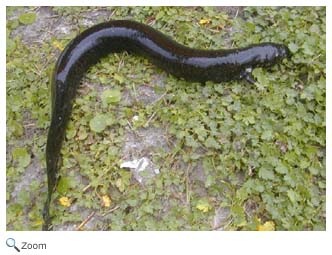|
 There are only four species of eel-like salamanders in this family. They are found in the southeastern United States and in the Mississippi valley. The dwarf siren is about 6 inches in length and the greater siren at can be as long as three feet in length. The lesser siren is about 11 inches in length. There are only four species of eel-like salamanders in this family. They are found in the southeastern United States and in the Mississippi valley. The dwarf siren is about 6 inches in length and the greater siren at can be as long as three feet in length. The lesser siren is about 11 inches in length.
Sirens are neotenic, that means they don't lose the characteristics they had as larvae when they become adults. They keep their large external gills and gill slits. Sirens are long and slender and have tiny front legs and no hind legs.
Sirens live in slow moving shallow water in swamps, lakes, ponds, and ditches. They are nocturnal and spend the day hidden under the mud or hidden in weeds and aquatic vegetation. They eat invertebrates and plants. Sirens aestivate when there is a drought. They dig into the mud and can live for 1-3 months covered in a cocoon of mucus that keeps them from drying out.
World Status Key
 Least Concern Least Concern  Near Threatened Near Threatened  Vulnerable Vulnerable  Endangered Endangered  Critically Endangered Critically Endangered  Extinct in Wild Extinct in Wild  Extinct Extinct
Status and range is taken from ICUN Redlist. If no status is listed, there is not enough data to establish status.
US Status Key
 Threatened in US Threatened in US  Threatened in NH Threatened in NH  Endangered in US Endangered in US  Endangered in NH Endangered in NH  Breeds N.H. Breeds N.H.  Introduced Introduced
Status taken from US Fish and Wildlife and NH Fish and Game
Location Key
 Africa Africa  Asia Asia  Australia Australia  Europe Europe  North America North America  South America South America  NH NH  Click for More Info Click for More Info  Click for Image Click for Image
Additional Information
Key:  Profile Profile  Photos Photos  Video Video  Audio Audio
Narrow-striped Dwarf Siren - Pseudobranchus axanthus    
The narrow-striped dwarf siren is found in Florida.
Source: AmphibiaWeb Intended Audience: General Reading Level: High School Teacher Section: No
Narrow-striped Dwarf Siren - Pseudobranchus axanthus    
The narrow-striped dwarf siren is also known as the southern dwarf siren.
Source: EDGE Intended Audience: General Reading Level: Middle School Teacher Section: No
Dwarf Siren - Pseudobranchus striatus    
The dwarf siren is found in southern South Carolina, southern Georgia, and Florida.
Source: AmphibiaWeb Intended Audience: General Reading Level: High School Teacher Section: No
Dwarf Siren - Pseudobranchus striatus   
The dwarf siren is nocturnal.
Source: Savannah River Ecology Lab Intended Audience: General Reading Level: Middle School Teacher Section: No
Dwarf Siren - Pseudobranchus striatus   
The dwarf siren is 4-6 inches in length.
Source: University of Georgia Museum of Natural History Intended Audience: General Reading Level: Middle School Teacher Section: No
Dwarf Siren - Pseudobranchus striatus    
The dwarf siren has external gills.
Source: EDGE Intended Audience: General Reading Level: Middle School Teacher Section: No
Lesser Siren - Siren intermedia    
The lesser siren is found from along the southern coastal plain from Virginia south to Florida and west to southern Texas and northeastern Mexico and along the Mississippi valley from Michigan to Louisiana.
Source: Animal Diversity Web Intended Audience: General Reading Level: Middle School Teacher Section: Yes
Lesser Siren - Siren intermedia    
Lesser sirens survive drought and the drying of their habitat by retreating into crayfish tunnels.
Source: AmphibiaWeb Intended Audience: General Reading Level: High School Teacher Section: No
Lesser Siren - Siren intermedia    
Lesser sirens are found in ditches, lakes, ponds, and streams.
Source: Savannah River Ecology Lab Intended Audience: General Reading Level: Middle School Teacher Section: No
Greater Siren - Siren lacertina    
The greater siren is found along the southern coastal plain from Virginia south to Florida and along the Gulf Coast from Florida to Alabama.
Source: AmphibiaWeb Intended Audience: General Reading Level: High School
Greater Siren - Siren lacertina    
The greater siren 19-38 inches in length.
Source: AmphibiaWeb Intended Audience: General Reading Level: High School
Greater Siren - Siren lacertina    
The greater siren is usually found in slow or still bodies of water that are heavily vegetated.
Source: Savannah River Ecology Lab Intended Audience: General Reading Level: Middle School Teacher Section: No |

